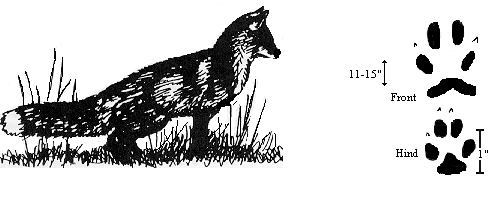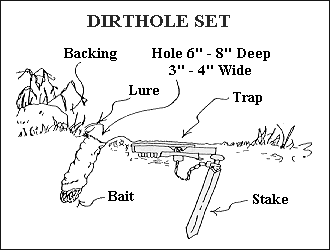

DISTRIBUTION: Found throughout North Dakota. More abundant in recent years than in any period since records have been kept. The red fox for many years was almost unknown in the southwestern part of the state. Since 1945 their numbers there have been increasing until they are now common throughout that area.
HABITAT: Red foxes are very adaptable and are found in almost all types of habitat. They usually make their dens near the top of a small hill and seem to prefer hilly country with fields and brush areas adjacent. Any area which has an abundance of small mammals will be attractive to red foxes as they are thus assured of a good food supply.
LIFE HISTORY: Red foxes breed in January or February and are largely monogamous. Their gestation period is 51 days and the young are born in March or April. From four to ten young may be born in a litter, the average is five or six. Foxes have only one litter a year. The fox kits remain in the nest for three to four weeks. During the period, both parents work to bring food to the den. The young foxes remain with their parents until fall. Foxes are solitary hunters and do not hunt in packs like their relatives the dogs and coyotes. Foxes often have more than one den and if a den is disturbed, they will move their young to another den.
The average red fox weighs from eight to twelve pounds although their heavy fur gives them the appearance of being much heavier than that.
Foxes do not hibernate but are active throughout the year. They do most of their hunting during the night but are not infrequently seen abroad during the daytime. Much of their normal daytime activity, however, consists of curling up and catching forty winks.
FOOD HABITS: Rabbits, mice, ground squirrels, small mammals, birds, carrion, poultry, insects, fruits, and small amounts of plant material are eaten by foxes. Foxes eat whatever food is most abundant and easy to catch. When rabbits and mice are abundant, they make up the bulk of the foxes' food supply. If they are scarce, the foxes will turn to other less easily caught species such as muskrats and game birds. If the poultry flock on a particular farm is not given some measure of protection, the fox finds the pickings good and changes to a poultry diet.
Rabbits and hares are one of the major sources of food for the red fox. When jack rabbits are abundant the red fox uses them as a major food source. When jack rabbits are scarce, the red fox evidently turns to other species for food. Apparently the abundance or scarcity of jack rabbits does not have any appreciable affect upon the population of red foxes and vice versa.
SUGGESTED BAITS: Fresh or tainted flesh such as rabbits, mice, ground squirrels, birds, etc.; partly decomposed flesh of house cats, fish, woodchucks, mice or small mammals.
Perhaps the best known, most publicized method of trapping foxes is the "dirt hole" set or "Old Indian" set. This set is designed to look like a spot where a fox has dug a small hole in search of a mouse or to bury a small amount of left over food. The dirt hole set can be made with very little equipment, although some trappers recommend that you take a whole trapper supply house with you. A small trowel, a hatchet, a trap and stake, clean cotton gloves, bait, lure, and fox urine are all you need.

The dirt hole set is usually made adjacent to a travel-way such as a trail, fence row, ridge top, field edge, or dry creek bottom where foxes normally travel. Select a bare, level spot in a clearing for this set. Wear clean cotton gloves and stand in one spot while making the set to avoid leaving human odor.